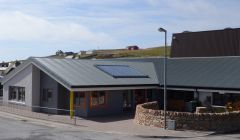Education / No plans to open schools in evenings as part of blended learning model
THERE are no plans locally to open schools in the evenings when a ‘blended learning’ model comes into play from mid-August, according to Shetland Islands Council.
It comes after former Ollaberry Primary School headteacher Peter Campbell, who is a Lerwick councillor, suggested that extending school opening hours could be one way to deal the challenge of spreading out learning as a result of reduced class sizes.
“It would be theoretically possible I would have thought that in the Covid situation you could have your most elderly secondary pupils coming in an evening, to maximise the use of the building,” he said, speaking in a personal capacity.
“If you’re having reduced class sizes then how do you spread them equitably over the week?”
However, a spokesperson or Shetland Islands Council confirmed that “there are no plans for schools to be open in the evening as part of the blended model of learning being developed for after the summer holidays”.
Pupils are due to return to schools in 11 August, with children set to receive a combination of in-school teaching and home learning.
The finer details of how this will be achieved is unclear, but it is expected that there will be smaller class sizes and social distancing measures in place.
There could also be staggered arrival and departure times.
Staff are able to return to schools in June to prepare for the new set-up.
The Scottish Government concedes, however, there “cannot be a ‘one size fits all’ approach to implementation across all education settings in Scotland, or perhaps even within a local authority area, due to the size, scale, location and geography of the country”.
Campbell, who was the headteacher in Ollaberry for over 20 years, said be believed that a closer look may need to be taken at how to best maximise the use of school buildings – particularly during a time of financial pressure.
Become a member of Shetland News
“Schools are expensive assets, and they’re only utilised for part of the day, part of the week, part of the year,” he said.
“I think as we go forward now, money is going to be much tighter given all the national government borrowing that there’s been.”
He suggested one way to use properties more “advantageously than at present” could be to have different age groups in school at different times – such as having older children in during evenings.
Campbell said this could be part of a “shift system” style of learning.
“It’s something that could probably more easily done in an urban area, where you don’t have transport implications,” he added.
The councillor also pondered whether there is a greater need to look at different ways to use school buildings to generate more income, particularly in evenings and holiday periods.
“Utilising the space for say…out of school activities, but using the school as the hub for that, for things like music and drama where there would be performances, and income could be generated,” Campbell said.
A framework on reopening schools published by the Scottish Government has suggested that local authorities could look at expanding the “learning estate” to maximise capacity for pupils.
This could include repurposing the parts of the public estate, including libraries and community halls, as well as using vacant business accommodation.
At the moment pupils continue to be based to home, with learning materials available online through education portal Glow.
It has not always been plain sailing for families in areas with poor internet connectivity, however, with some parents reporting problems with uploading and downloading work.
Become a member of Shetland News
Shetland News is asking its readers to consider paying for membership to get additional perks:
- Removal of third-party ads;
- Bookmark posts to read later;
- Exclusive curated weekly newsletter;
- Hide membership messages;
- Comments open for discussion.
If you appreciate what we do and feel strongly about impartial local journalism, then please become a member of Shetland News by either making a single payment, or setting up a monthly, quarterly or yearly subscription.









































































